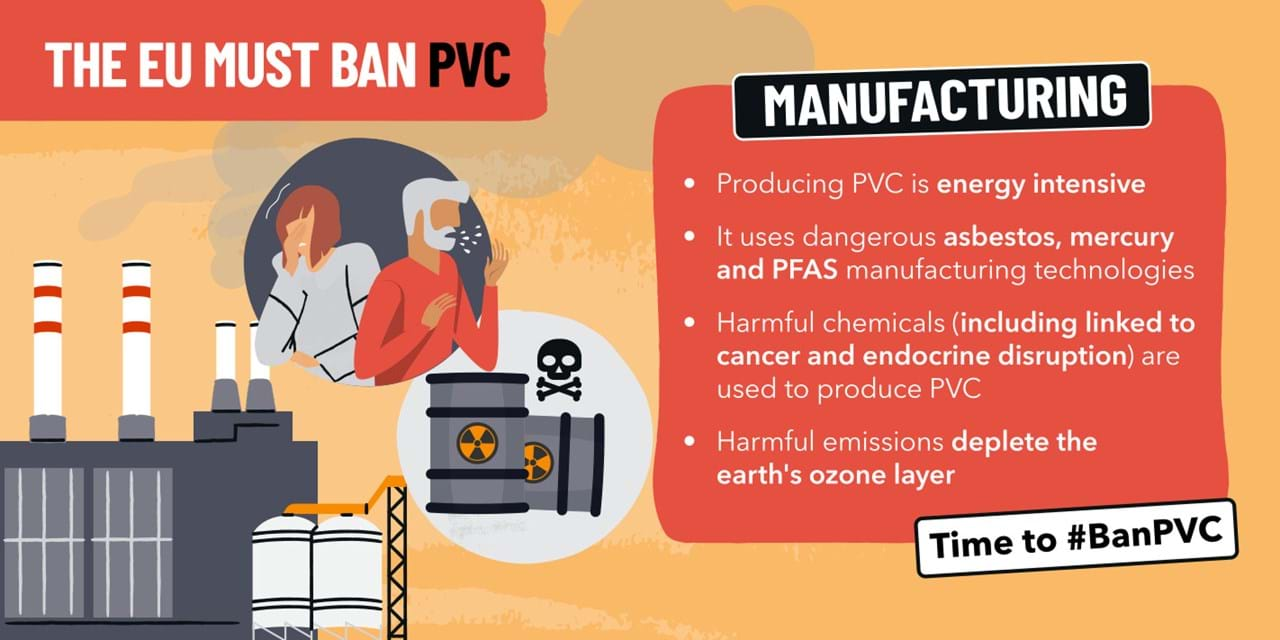ClientEarth Communications
31st May 2024


Vinyl - your first thought might be either records, or flooring. But the truth is more toxic.
PVC (Polyvinyl chloride) is a type of hard plastic found everywhere around us – in packaging, flooring, pipes, children’s toys and hundreds of other products.
It is durable and relatively cheap, which is why PVC is one of the most widely used plastics in the world. But the price we pay as a society, due to damages to health and the environment, is steep.
The core building block of PVC is carcinogenic. In order to make it more bendy, it contains more additives such as phthalates, which are known endocrine disruptors – substances that disrupt the normal hormone function in your body. And when it burns, it can spew noxious dioxins.
Like PFAS (an infamous group of harmful chemicals), tiny particles of PVC that end up in the environment accumulate and remain present for long periods of time. The impact that this growing mass of toxic plastic could have on us and our environment is huge. That’s why we need to take action now.

Yes, PVC is toxic to health and the environment at every stage of its lifecycle – from production to disposal.
The health hazards associated with the use of and exposure to PVC and its harmful components are alarming:
The environmental impacts are also disastrous. PVC’s toxins end up in our water, air and soil, with associated effects on wildlife. Following the derailment of a freight train carrying PVC in Ohio in February 2023, nearly 45,000 animals died.


Alternatives to PVC do exist. Those alternative types of plastics usually contain less harmful additives, without compromising on durability. Non-plastic alternatives to PVC include glass, natural rubber and ceramics.
In fact, European authorities, in a recent report, explained that alternative materials to PVC are available in all uses covered in their assessment, including pipes, cables, flooring, window frames, packaging, blister packs, toys, medical applications and artificial leather.
It’s also worth remembering that, as a society, we urgently need to move away from plastic. PVC is only one of over 16,000 chemicals present in plastic products – 4,000 of which are hazardous to human health and the environment. The core issue is that what’s put in plastics doesn’t stay in plastics – the chemicals leach. And that’s why we need to significantly reduce plastic production.
Authorities have had PVC on their radar for decades. As far back as 2000, the European Commission recognised that PVC causes a wide range of serious problems for the environment and human health.
More recently, in 2022, the EU included PVC and its additives in its list of hazardous chemicals that should be restricted – known as the Restriction Roadmap. As a follow-up, the European Chemicals Agency was asked to provide a detailed report on the risks linked to PVC and consider recommendations for action. The report, published in November 2023, shows that PVC poses a risk that currently lacks adequate control and that alternatives are available to replace most uses.
Yet since the publication of that long-awaited report, the European Commission hasn't taken any concrete steps towards actually banning PVC and its dangerous additives. They’re still on the market, while clear evidence of their danger sits on file.
We, alongside the European Environmental Bureau, Zero Waste Europe and Health Care Without Harm have reviewed the ECHA report and produced a detailed analysis, concluding that the EU is failing in its legal duty by not placing a restriction on PVC, or regulating its dangerous additives.
The evidence provided by ECHA more than warrants this regulatory action by EU decision-makers.
Our legal expert Hélène Duguy said:
When there’s sufficiently serious evidence that damages to the environment or people’s health may occur, the EU is legally bound to act. The harms of PVC to the environment and health have now been too well-documented, including by the EU authorities. There’s no reason to stall any further.